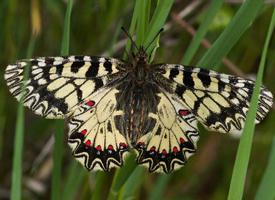
Popis zvířete
The Scarce Swallowtail (Iphiclides podalirius L.), a visually striking and elegant butterfly, belongs to the family Papilionidae, which is renowned for its large size and vibrant patterns. This species, characterized by its distinctive wing shape and coloration, is found across a wide range of habitats in Europe and Asia, from Spain in the west to Kazakhstan in the east, and from Scandinavia in the north to North Africa and the Middle East in the south. Despite its name, the Scarce Swallowtail is relatively common in many of its habitats, though its populations can be localized and subject to fluctuations.Adults of the Scarce Swallowtail exhibit a wingspan ranging from 65 to 80 millimeters, making them one of the more prominent butterfly species within their geographical range. The wings are predominantly white, adorned with black vein markings and a series of blue and red spots near the tail, which resembles that of a swallow, hence the name "Swallowtail." This tail-like extension, along with the dramatic wing patterns, not only adds to its aesthetic appeal but also serves as a mechanism to evade predators, drawing attacks away from the more vital body parts.
The underside of the wings features a more subdued color palette, with shades of yellow, blue, and red, providing excellent camouflage against predators when the butterfly is at rest among flowers and foliage. The intricate patterns and colors serve as a deterrent to potential predators, signaling the butterfly's unpalatable taste, a common trait among many species in the Papilionidae family.
Scarce Swallowtails undergo a complete metamorphosis, with life stages that include egg, larva (caterpillar), pupa (chrysalis), and adult. The caterpillars are equally striking, with a green and black striped pattern, punctuated by orange and yellow spots, allowing them to blend seamlessly into their surroundings, primarily on the leaves of various host plants such as Blackthorn (Prunus spinosa) and Ash (Fraxinus excelsior). These plants serve as crucial food sources for the larvae, enabling them to grow and eventually pupate.
The species is multivoltine, meaning it can produce several generations within a year, especially in warmer climates. Adults are most commonly seen from April to September, depending on the geographic location and climatic conditions. They are active during the day, particularly in sunny, open areas where flowers are abundant, as they feed on nectar from a wide variety of plants.
Despite its relative abundance in certain areas, the Scarce Swallowtail faces threats from habitat loss, climate change, and pesticide use, which can impact its populations. Conservation efforts aimed at preserving natural habitats and promoting biodiversity are crucial for ensuring the survival of this and many other butterfly species.
In summary, the Scarce Swallowtail is a mesmerizing creature, emblematic of the beauty and complexity of the natural world. Its presence enhances the biodiversity of its habitats, serving as a pollinator and a part of the food web. As such, it remains a subject of interest for conservationists, naturalists, and butterfly enthusiasts around the globe.
Podobná zvířata
Nové fotografie zvířat
Top 10 zvířat
- Dolphin gull (Leucophaeus scoresbii)
- Diana monkey (Cercopithecus diana)
- Moustached guenon (Cercopithecus cephus)
- Galápagos tortoise (Geochelone nigra complex)
- Russian tortoise (Testudo horsfieldii)
- Japanese macaque (Macaca fuscata)
- Stone loach (Barbatula barbatula)
- Greek tortoise (Testudo graeca)
- Common flying dragon (Draco volans)
- Colossal squid (Mesonychoteuthis hamiltoni)


